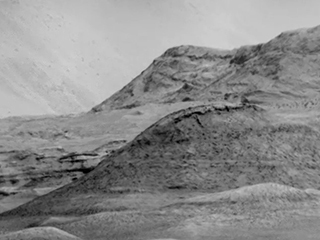
One key activity for NASA's Perseverance Mars rover, which is on its way to the Red Planet, will be to collect samples of Martian rock and regolith (broken rock and dust) for future return to Earth.
A future mission, which involves a collaboration between NASA and the European Space Agency, will return the samples to Earth. The Perseverance rover is set to land on the surface of Mars on February 18, 2021.
* * *
[Thora Maltais] We are working on something that is the cleanest we've ever really attempted to send into space.
Many things are taking place:
Your Stargazing Guide To Winter: 'Christmas Star,' A Triple Conjunction And Mars Visits 'Seven

Venus (at left) and Jupiter close together in the dawn sky, and to the east of Scorpius, here at ... [+] right, with reddish Antares between the trees. This was January 26, 2019. The two planets were closer together earlier in the week but clouds got in the way! Illumination is from the waning gibbous Moon off frame at right.
Are you ready for a new season of stargazing? If you've used the lengthy lockdowns of 2020 to point your eyes to the skies and learn a little about the night sky you're probably wondering what's in store for the new season.
Curiosity's "Spyglass" Megamosaic of Mount Sharp – NASA's Mars Exploration Program

A quick introduction, since I'm not a regular author of Curiosity's blog: since the rover's landing, I’ve been involved in the processing of ChemCam’s images at France's University of Nantes. I'm always eager when new data come down, and the images we've collected here as a video are a real treat.
The recent “Housedon Hill” imaging campaign planned by the team during a two-month period while staying at the “Mary Anning” drill site broke a record, being the largest mosaic obtained so far with ChemCam’s Remote Micro-Imager (RMI). RMI was originally designed to document the tiny areas analyzed by ChemCam’s laser-induced breakdown spectroscopy (LIBS) technique on rocks only a few meters from the rover.
Fluvial mapping of Mars -- ScienceDaily
![]()
It took fifteen years of imaging and nearly three years of stitching the pieces together to create the largest image ever made, the 8-trillion-pixel mosaic of Mars' surface. Now, the first study to utilize the image in its entirety provides unprecedented insight into the ancient river systems that once covered the expansive plains in the planet's southern hemisphere.
The work, published this month in Geology , complements existing research into Mars' hydrologic history by mapping ancient fluvial (river) ridges, which are essentially the inverse of a riverbed. "If you have a river channel, that's the erosion part of a river. So, by definition, there aren't any deposits there for you to study," Jay Dickson, lead author on the paper, explains. "You have rivers eroding rocks, so where did those rocks go? These ridges are the other half of the puzzle.
This may worth something:
How to get people from Earth to Mars and safely back again

The two major players are NASA and SpaceX, which work together intimately on missions to the International Space Station but have competing ideas of what a crewed Mars mission would look like.
The biggest challenge (or constraint) is the mass of the payload (spacecraft, people, fuel, supplies etc) needed to make the journey.
* * *
But it could launch only 140 tonnes (5% of its initial launch mass) to low Earth orbit, and 50 tonnes (less than 2% of its initial launch mass) to the Moon.
For NASA, It Should Be Mars or Bust - WSJ
Since the Apollo program ended almost 50 years ago, every newly elected U.S. president has been vexed by the same question: Where next to send astronauts?
NASA's current target is the moon, but the moon belongs to a previous generation of American pioneers. A grander, more fitting ambition for the space program that first landed human beings on another heavenly body is Mars—a destination that NASA has been preparing to reach since the days of its early visionaries. It is now time to realize their dream.
NASA probe on Mars may feel the ground shake as rovers land in 2021 | New Scientist

For the first time in history, the landing of a spacecraft on Mars might be "heard" in an unusual way – by the seismic waves it produces as it punches the surface of the planet.
The ears in this scenario are built into NASA's InSight lander , which touched down in a region called Elysium Planitia on Mars in 2018. Since then, the stationary lander has been using instruments to study the planet's geology, including a seismometer to detect seismic waves, and has found hundreds of seismic events known …
NASA Opens Limited Media Credentialing for Mars Perseverance Landing | NASA
Happening on Twitter
Statement by Donald J. Trump, The President of the United States Full Video: https://t.co/avKfYctPAD https://t.co/i8IMLhH53Q realDonaldTrump (from Washington, DC) Wed Dec 23 02:04:52 +0000 2020
#NotiMippCI 📰🗞| Festival de Ciencias en Videos premia creatividad y compromiso comunitario. Lea más ⏩… https://t.co/rJST8xlhai Mippcivzla (from Venezuela) Thu Dec 24 00:40:00 +0000 2020
Apoya esta campaña de los familiares de presos políticos en Ramo Verde y La Pica, quienes exigen poder visitar a su… https://t.co/CvSBgRL3cu alfredoromero (from Caracas) Wed Dec 23 11:36:51 +0000 2020
People around the world shared a moment of unity Dec. 21 when we looked up to admire the same thing: the Great Conj… https://t.co/kils7aSTB4 NASA Tue Dec 22 16:20:00 +0000 2020



No comments:
Post a Comment